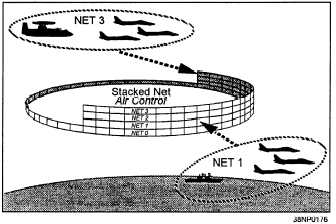Transmission Protocols
Since Link-16 exchanges much of the same data
that is used in both Link-11 and Link-4A, a brief
comparison of the architectures, the capacities, and
the data rates of the three systems is useful.
During normal operation, Link-11 operates using
the protocols of the Roll Call mode. In this mode,
each participating unit is polled by the NCS to
transmit data. On completion of data transmission,
the unit returns to the receive mode and the next unit
is polled until all units have been polled. This cycle
is continuously repeated. Link-11 messages are called
M series messages.
Link-4A uses the time-division multiplexing
principle with a command-and-response protocol to
enable the operator to control multiple aircraft
independently on the same frequency. Link-4A
messages sent to the controlled aircraft are referred to
as V series messages and messages received from the
controlled aircraft are called R series messages.
Link- 16 uses the Time-Division Multiple Access
(TDMA) principle of data communications. Using
this architecture with time interlacing provides the
system with multiple and apparently simultaneous
communications nets. Instead of assigning each unit
a PU number, Link-16 assigns each unit a JTIDS
Unit number, or JU. The JU identifies the units and
determines a preassigned set of time slots that
designate when the unit transmits and receives data.
Each time slot is 1/128 of a second, or 7.8125
milliseconds, in duration.
When a JU transmits data, the frequency that the
data is transmitted on is changed every 13
microseconds (µsec), according to a predetermined
pseudo-random pattern. Link-16 uses 51 different
frequencies for data exchange. This frequency
hopping adds to the security and integrity of the
system by making it nearly impossible to jam.
Link-16 Nets
Link-16 has the capability to handle multiple nets.
A Link-16 net is a group of participants sharing
mutually beneficial tactical information. For
example, using the Link-11 system, a net is formed by
a group of participants. These participants operate on
the same frequency. A separate net is formed when
another group of participants operates on a different
frequency. The second net would be used by
participants involved in a fleet exercise that wouldn’t
want the exercise data to interfere with the normal
tactical net. The controlling station and aircraft using
Link-4A is also a net.
Link-16 has the ability to form multiple nets. The
Link-16 system has 128 numbers used to designate
particular nets (00-127). Net number 127 is reserved
to indicate a stacked net. A stacked net is formed by
setting up the time slots so that they have the same
set, initial slot number, and recurrence rate. When
the system is initialized, the use of net number 127
indicates a stacked net is to be used and the operator
can then specify locally which net to use for
operations. Figure 7-5 illustrates the concept of a
stacked net used for air control. Net 1 is a group of
aircraft controlled by the ship, while Net 3 is a group
of aircraft controlled by an E-2. If the E-2 requires
additional aircraft, the ship can direct the aircraft
under its control to the E-2. As the aircraft
approaches the E-2, the pilot can switch to Net 3 and
immediately become an active participant in the new
net. Even though the operator has several nets
available to monitor or use, a single terminal can
transmit or receive on only one of them for each time
slot. Stacked nets are possible because the frequency-
hopping pattern is different for each net. Examples of
stacked nets are voice nets and control nets.
Figure 7-5.—Stacked nets using Link-16.
7 - 5


